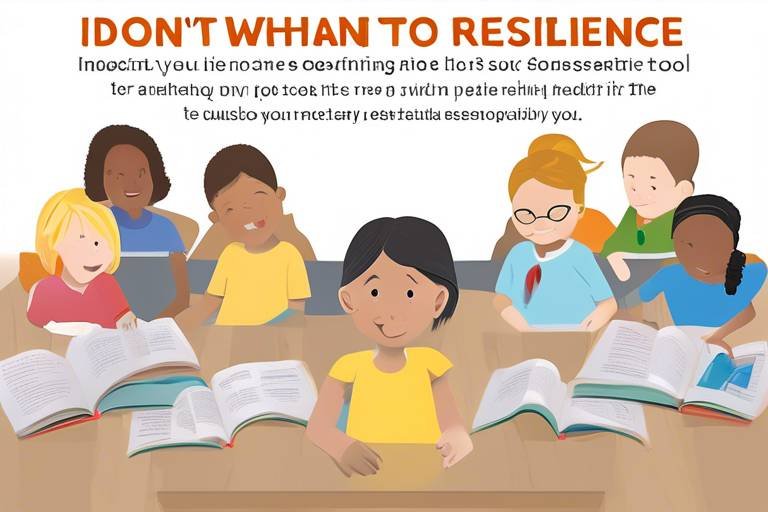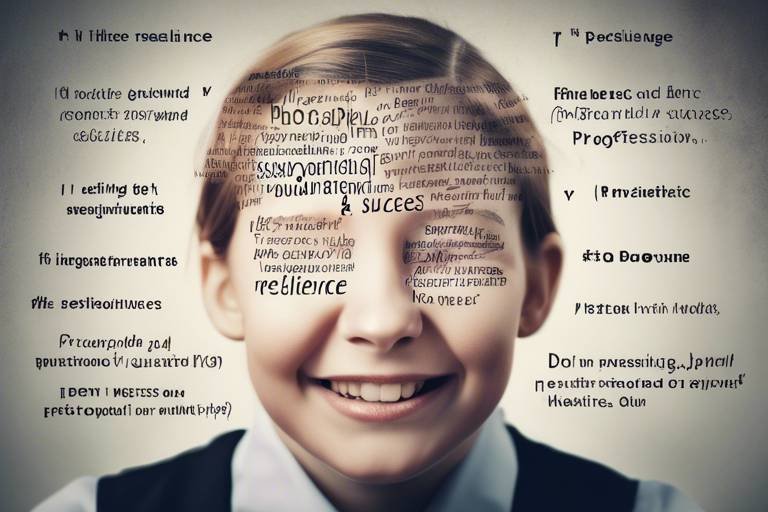Building Resilience in a Multicultural Workplace
In today’s globalized world, workplaces are becoming increasingly diverse. With employees hailing from various cultural backgrounds, building resilience in a multicultural environment is more important than ever. Resilience, in this context, refers to the ability of teams to adapt, thrive, and collaborate effectively despite differences. By fostering an atmosphere that embraces cultural diversity, organizations can unlock a treasure trove of creativity and innovation. But how do we achieve this? Let’s dive into some strategies that can help cultivate resilience in such dynamic settings.
Cultural awareness is the cornerstone of resilience in a multicultural workplace. When team members understand and appreciate their colleagues' backgrounds, it significantly reduces the chances of misunderstandings and fosters a more inclusive atmosphere. Imagine a ship sailing through turbulent waters; cultural awareness acts as the compass that guides the crew safely to their destination. By recognizing and respecting differences, employees can work more effectively and harmoniously, creating a cohesive unit that can tackle challenges head-on.
Implementing effective communication strategies is crucial in multicultural teams. Clear and respectful communication serves as a bridge that connects diverse perspectives, minimizing conflicts and enhancing collaboration. Think of communication as a dance; each partner must be aware of the other's moves to perform beautifully together. This requires not just speaking, but also active listening—a vital skill that encourages understanding and empathy.
Active listening involves fully concentrating on what is being said, rather than just passively hearing the message. This practice allows team members to appreciate diverse viewpoints, fostering a supportive work environment. Consider it like tuning into a favorite song; when you truly listen, you can appreciate the nuances that make it special. Techniques such as nodding, summarizing, and asking clarifying questions can enhance this skill.
Establishing feedback mechanisms is another essential component. By allowing employees to express their thoughts and concerns, organizations promote a culture of openness. This not only helps in identifying areas for improvement but also strengthens team dynamics. Regular feedback sessions can be likened to a gardener tending to plants; consistent care leads to a flourishing garden.
Understanding non-verbal cues is equally important in a multicultural setting. Different cultures have unique gestures and body language that can alter the meaning of a message. For example, a thumbs-up may signify approval in some cultures, while it can be offensive in others. By recognizing these differences, teams can enhance communication and prevent misinterpretations, ultimately leading to a more cohesive work environment.
Conflicts are inevitable in any workplace, but effective conflict resolution is key to maintaining resilience in diverse teams. Addressing conflicts promptly and constructively can transform potential disruptions into opportunities for growth. Think of it as a storm that, when navigated well, can lead to clearer skies and a stronger team bond.
Trust is the foundation of any successful workplace. In multicultural settings, building trust requires intentional efforts to understand and respect each other's cultural backgrounds and values. It’s like constructing a bridge; each plank represents a shared experience or understanding, and together, they create a strong structure that can withstand pressures.
Engaging in team-building activities can significantly strengthen relationships among employees. These activities promote bonding and help team members appreciate each other's strengths and cultural differences. Whether it's a workshop or a fun outing, these experiences can create shared memories that reinforce trust.
Implementing mentorship programs is another effective strategy. By pairing experienced employees with newcomers, organizations can foster a sense of belonging and help bridge cultural gaps. This guidance can be invaluable, much like having a seasoned navigator on a voyage through unfamiliar waters.
Creating an inclusive workplace is essential for resilience. By encouraging diverse perspectives and ensuring that everyone feels valued, organizations can cultivate a more innovative and adaptable team environment. Inclusivity is not just a buzzword; it’s a vital ingredient for success in today’s diverse workplaces.
- What is cultural awareness?
Cultural awareness is the understanding and appreciation of different cultural backgrounds and practices, which helps to foster a more inclusive workplace.
- How can I improve communication in a multicultural team?
Implementing active listening techniques, providing feedback mechanisms, and being aware of non-verbal cues can significantly enhance communication in multicultural teams.
- Why is trust important in a multicultural workplace?
Trust is foundational for collaboration and teamwork. It helps create a safe environment where employees feel valued and respected, leading to better performance.
- What are some effective team-building activities?
Activities can range from workshops and retreats to casual outings, all aimed at strengthening relationships and promoting understanding among team members.

The Importance of Cultural Awareness
Cultural awareness is not just a buzzword; it's a vital ingredient for success in today's diverse work environments. Imagine a tapestry woven from countless threads, each representing a different culture, background, and perspective. When we embrace this diversity, we create a rich fabric that enhances creativity, innovation, and collaboration. Understanding cultural differences is crucial because it helps mitigate misunderstandings that can arise in a multicultural setting. For instance, a simple gesture that is considered polite in one culture might be perceived as rude in another. By recognizing and respecting these differences, we can foster a more inclusive workplace where everyone feels valued.
Moreover, cultural awareness promotes a sense of belonging among employees. When team members feel that their unique backgrounds are acknowledged and respected, they are more likely to engage fully in their work. This engagement not only boosts morale but also enhances productivity. In fact, studies have shown that diverse teams are more innovative and better at problem-solving. They bring varied perspectives to the table, which can lead to creative solutions that a homogenous team might overlook.
To illustrate the impact of cultural awareness, consider the following key benefits:
- Enhanced Communication: Understanding cultural nuances leads to clearer communication and reduces the potential for conflicts.
- Increased Collaboration: When employees appreciate each other's backgrounds, they are more likely to collaborate effectively.
- Improved Employee Retention: A culturally aware workplace fosters loyalty and reduces turnover rates.
In summary, cultural awareness is the cornerstone of resilience in a multicultural workplace. By actively promoting understanding and respect for different cultures, organizations can create an environment where all employees thrive. So, let’s not just acknowledge our differences; let’s celebrate them! This celebration can transform our workplaces into hubs of innovation and collaboration, ultimately leading to greater success for everyone involved.
Implementing effective communication strategies is essential in multicultural teams...
- What is cultural awareness? Cultural awareness is the understanding and appreciation of cultural differences and similarities.
- Why is cultural awareness important in the workplace? It enhances communication, fosters collaboration, and improves employee retention.
- How can organizations promote cultural awareness? Through training programs, team-building activities, and open discussions about cultural differences.

Effective Communication Strategies
In a multicultural workplace, effective communication isn't just a nice-to-have; it's a must-have. When employees hail from different cultural backgrounds, the way they communicate can vary significantly. This variation can lead to misunderstandings if not managed properly. So, how can we ensure that our communication strategies are effective in such a diverse environment? Let’s dive into a few key strategies that can help bridge those cultural gaps.
First and foremost, it's essential to establish a culture of respect and openness. This means encouraging team members to express themselves freely while also being mindful of the cultural nuances that might affect their communication styles. For instance, in some cultures, direct communication is valued, while in others, a more indirect approach is preferred. By fostering an atmosphere where everyone feels comfortable sharing their thoughts, organizations can significantly reduce the potential for conflict.
Another crucial aspect is active listening. This skill goes beyond just hearing what someone says; it involves understanding the message behind the words. When team members practice active listening, they show genuine interest in their colleagues' perspectives. This not only helps in building rapport but also promotes empathy. To enhance active listening, consider the following techniques:
- Maintain Eye Contact: This shows that you are engaged and interested in the conversation.
- Ask Clarifying Questions: If something isn't clear, don't hesitate to ask for more information.
- Paraphrase: Repeat back what you've heard in your own words to confirm understanding.
Moreover, establishing feedback mechanisms is vital. This allows team members to express their thoughts and concerns openly. Regular feedback sessions can help identify areas for improvement and reinforce positive behaviors. When employees feel that their input is valued, they are more likely to contribute, leading to a more harmonious workplace.
Now, let’s not forget about the power of non-verbal communication. In a multicultural setting, non-verbal cues can vary widely. What might be considered a friendly gesture in one culture could be perceived differently in another. For example, while maintaining personal space is crucial in some cultures, others may be more comfortable with close proximity. Understanding these differences can significantly enhance communication and prevent misinterpretations.
In summary, effective communication in a multicultural workplace requires intentionality and awareness. By fostering respect, practicing active listening, establishing feedback mechanisms, and being mindful of non-verbal cues, organizations can create a more cohesive and resilient team environment. Remember, communication is not just about exchanging information; it's about building relationships and understanding each other on a deeper level.

Active Listening Techniques
Active listening is more than just hearing words; it's about truly understanding the message behind them. In a multicultural workplace, where diverse backgrounds and experiences shape communication styles, mastering active listening can create a bridge that fosters connection and collaboration. Imagine you're trying to tune into a radio station with a weak signal; you need to adjust the dial just right to catch the full melody. Similarly, active listening requires effort and focus to grasp the nuances of what others are saying.
To enhance active listening, consider the following techniques:
- Maintain Eye Contact: This simple act shows the speaker that you are engaged and interested. It’s like giving them a gentle nudge that says, “I’m here, and I care about your words.”
- Use Open Body Language: Your body language speaks volumes. Leaning slightly forward and nodding at appropriate moments can convey that you are receptive and supportive. Imagine your body as a welcoming door; the more open it is, the easier it is for others to walk through and share their thoughts.
- Paraphrase and Summarize: Reflecting back what you’ve heard not only confirms your understanding but also shows the speaker that their message is valued. For example, you might say, “So what I’m hearing is that you feel…” This technique helps clarify any misunderstandings and reinforces the connection between team members.
- Avoid Interrupting: It’s tempting to jump in with your thoughts, but interrupting can derail the conversation and make the speaker feel undervalued. Think of it as a dance; each partner has their moment to shine without stepping on each other's toes.
Moreover, creating an environment that encourages active listening can significantly impact team dynamics. For instance, consider setting aside dedicated time for discussions where everyone can share their views without distractions. This could be during regular team meetings or even informal catch-ups over coffee. By prioritizing active listening, you're not just enhancing communication; you're building a culture of respect and understanding.
In summary, active listening is a powerful technique that can transform interactions in a multicultural workplace. By embracing these strategies, team members can cultivate a supportive atmosphere that values diverse perspectives, ultimately leading to greater resilience and collaboration. Remember, the goal is not just to hear but to truly listen and understand, creating a harmonious work environment where everyone feels heard and appreciated.
Q: What is active listening?
Active listening is a communication technique that involves fully concentrating, understanding, responding, and remembering what is being said. It goes beyond just hearing words; it requires engagement with the speaker.
Q: Why is active listening important in a multicultural workplace?
In a multicultural workplace, active listening helps bridge cultural differences, reduces misunderstandings, and fosters a collaborative environment where all team members feel valued and respected.
Q: How can I improve my active listening skills?
You can improve your active listening skills by practicing techniques such as maintaining eye contact, using open body language, paraphrasing what others say, and avoiding interruptions.
Q: What are some common barriers to active listening?
Common barriers include distractions, preconceived notions, emotional reactions, and cultural differences that may influence how messages are interpreted. Being aware of these barriers can help you overcome them.

Feedback Mechanisms
Establishing in a multicultural workplace is not just a good practice; it’s a necessity for fostering resilience among team members. Imagine a garden where each plant has its unique needs; without proper attention and care, some may flourish while others wither away. Similarly, feedback mechanisms allow employees to express their thoughts and concerns, ensuring that everyone’s voice is heard and valued.
When we talk about feedback, it's essential to create an environment where team members feel safe to share their opinions. This can be achieved through various methods, such as regular one-on-one check-ins, anonymous surveys, or even open forums where employees can freely discuss their experiences. Each of these approaches can serve as a channel for communication, shedding light on areas that require improvement and fostering a culture of openness.
One effective way to implement these mechanisms is through the use of anonymous surveys. These surveys can be designed to gauge employee satisfaction, gather insights on team dynamics, and identify potential cultural misunderstandings. By allowing employees to share their feedback without the fear of judgment, organizations can uncover valuable information that may have otherwise remained hidden. Here’s a simple table to illustrate some common feedback mechanisms:
| Feedback Mechanism | Description | Benefits |
|---|---|---|
| One-on-One Check-ins | Regular meetings between employees and managers | Builds relationships and trust |
| Anonymous Surveys | Surveys conducted without revealing the identity of respondents | Encourages honest feedback |
| Open Forums | Group discussions where employees can voice their opinions | Promotes a sense of community |
Moreover, feedback should not be a one-way street. It’s equally important for management to provide constructive feedback to employees. This reciprocal exchange fosters a culture of continuous improvement and helps identify areas for personal and professional growth. When employees see that their input leads to tangible changes, it not only boosts morale but also enhances their commitment to the organization.
Incorporating feedback mechanisms also plays a crucial role in identifying cultural nuances that may affect team dynamics. For instance, some cultures value direct feedback, while others may prefer a more subtle approach. Understanding these differences can help tailor feedback processes that resonate with all team members, ensuring everyone feels included and respected.
In conclusion, feedback mechanisms are vital for nurturing resilience in a multicultural workplace. By establishing open channels of communication, organizations can create a supportive environment where employees feel empowered to share their thoughts and contribute to the team’s success. Remember, just like a well-tended garden, a thriving workplace requires attention, understanding, and a willingness to adapt.
- What are feedback mechanisms? Feedback mechanisms are tools or processes that allow employees to share their thoughts, opinions, and concerns about their work environment.
- Why are feedback mechanisms important in multicultural workplaces? They help to ensure that all voices are heard, promote inclusivity, and can identify cultural misunderstandings that may affect team dynamics.
- How can I encourage my team to provide feedback? Create a safe and open environment for discussions, use anonymous surveys, and demonstrate that feedback leads to real changes.
- What are some examples of feedback mechanisms? Examples include one-on-one check-ins, anonymous surveys, and open forums.

Non-Verbal Communication
In a multicultural workplace, plays a pivotal role in how messages are conveyed and interpreted. Often, what we say is only part of the story; our body language, facial expressions, and even our tone can significantly impact the clarity and reception of our communication. For example, a smile can be a universal sign of friendliness, but the way we use our hands or maintain eye contact can vary widely across cultures. This difference can lead to misunderstandings if not properly addressed.
Understanding non-verbal cues is essential for fostering effective communication among diverse teams. Here are a few key aspects to consider:
- Facial Expressions: While emotions like happiness and sadness are universally recognized, the intensity and appropriateness of these expressions can differ. For instance, some cultures may view a broad smile as genuine warmth, while others might perceive it as insincerity.
- Gestures: Hand signals can have vastly different meanings in different cultures. A gesture that is considered positive in one culture could be offensive in another. For example, the thumbs-up sign is a sign of approval in many Western cultures but can be seen as rude in parts of the Middle East.
- Personal Space: The concept of personal space varies significantly across cultures. In some cultures, close proximity is a sign of warmth and friendliness, while in others, it may be perceived as intrusive.
To enhance non-verbal communication in a multicultural setting, it's crucial to foster an environment where team members feel comfortable discussing their cultural norms. This openness can help to clarify any potential misinterpretations and create a more cohesive team dynamic. For instance, consider organizing workshops or training sessions focused on cultural awareness. These can provide valuable insights into the various non-verbal communication styles present within your team.
Moreover, encouraging team members to observe and ask questions about each other's non-verbal communication can lead to a deeper understanding and appreciation of diverse perspectives. This practice not only promotes empathy but also strengthens interpersonal relationships within the team. Remember, effective communication is not just about speaking; it's about listening and observing as well.
Q1: Why is non-verbal communication important in a multicultural workplace?
A1: Non-verbal communication is crucial because it can convey messages that words alone may not express. Understanding these cues helps prevent misunderstandings and fosters better collaboration among team members from different cultural backgrounds.
Q2: How can I improve my non-verbal communication skills?
A2: You can improve your non-verbal communication skills by being aware of your body language, practicing active listening, and observing the non-verbal cues of others. Engaging in cultural awareness training can also enhance your understanding of different communication styles.
Q3: What should I do if I misinterpret someone's non-verbal cues?
A3: If you misinterpret someone's non-verbal cues, it’s best to address the situation openly. Apologize if necessary, and ask for clarification. This not only resolves the misunderstanding but also shows your willingness to learn and adapt.

Conflict Resolution Approaches
In any workplace, conflicts are bound to arise, especially in a multicultural environment where diverse perspectives and backgrounds converge. The key to maintaining a resilient and productive atmosphere lies in how these conflicts are addressed. Rather than letting disagreements fester, organizations should adopt proactive and constructive . One effective method is to encourage open dialogue among team members. This means creating a safe space where individuals feel comfortable expressing their concerns without fear of retaliation or judgment. By fostering an environment of trust, employees are more likely to engage in honest conversations that can lead to understanding and resolution.
Another essential strategy is to employ a collaborative problem-solving approach. This involves bringing conflicting parties together to discuss their viewpoints and work towards a mutually beneficial solution. During these discussions, it's crucial to focus on the issue at hand rather than personal attacks. By emphasizing shared goals and common ground, teams can transform conflicts into opportunities for growth and learning. For instance, consider a situation where two team members disagree on a project direction. Instead of allowing their disagreement to escalate, they could sit down together, outline their differing perspectives, and brainstorm a solution that incorporates elements from both sides.
Additionally, organizations can benefit from utilizing trained mediators when conflicts become particularly challenging. Mediators can help facilitate discussions, ensuring that all voices are heard and guiding the conversation towards resolution. This third-party perspective can often bring clarity to the situation and help de-escalate tensions. It's like having a referee in a sports game; their presence can keep the focus on fair play and teamwork.
Moreover, it's vital to establish clear conflict resolution policies within the organization. These policies should outline the steps employees can take when conflicts arise, providing a structured approach to resolution. A well-defined process not only empowers employees but also demonstrates that the organization values a harmonious workplace. Here’s a simple framework for conflict resolution:
| Step | Description |
|---|---|
| 1. Identify the Conflict | Recognize and acknowledge that a conflict exists. |
| 2. Gather Information | Collect relevant facts and perspectives from all parties involved. |
| 3. Discuss the Issue | Encourage open dialogue to explore each person's viewpoint. |
| 4. Develop Solutions | Collaborate to find a resolution that satisfies all parties. |
| 5. Implement and Follow Up | Put the solution into action and check in to ensure effectiveness. |
By following these steps, organizations can not only resolve conflicts effectively but also strengthen relationships among team members. It's about turning challenges into stepping stones for a more cohesive and resilient workplace. Remember, when conflicts are handled well, they can lead to deeper understanding and collaboration, ultimately enriching the multicultural fabric of the organization.
- What are some common causes of conflict in multicultural workplaces?
Common causes include miscommunication, differing cultural norms, and varying work styles. - How can I improve my conflict resolution skills?
Practice active listening, remain open-minded, and engage in empathetic dialogue. - Is it necessary to involve a mediator in every conflict?
Not always; mediators are typically used for more complex or escalating conflicts. - Can conflicts lead to positive outcomes?
Absolutely! When resolved constructively, conflicts can enhance teamwork and innovation.

Building Trust Among Team Members
This article explores strategies for fostering resilience in diverse work environments, emphasizing the importance of understanding cultural differences and promoting collaboration among employees from various backgrounds.
Cultural awareness is crucial for fostering resilience. Understanding different backgrounds helps mitigate misunderstandings and promotes a more inclusive workplace, enabling teams to work effectively and harmoniously.
Implementing effective communication strategies is essential in multicultural teams. Clear and respectful communication helps to bridge cultural gaps, reducing conflicts and enhancing collaboration among employees.
Active listening is a vital communication skill that encourages understanding and empathy. By practicing active listening, team members can better appreciate diverse perspectives and foster a supportive work environment.
Establishing feedback mechanisms allows employees to express their thoughts and concerns. This promotes a culture of openness and helps identify areas for improvement in team dynamics.
Understanding non-verbal cues is essential in a multicultural setting. Recognizing gestures and body language can enhance communication and prevent misinterpretations among team members from different cultures.
Effective conflict resolution is key to maintaining resilience in diverse teams. By addressing conflicts promptly and constructively, organizations can foster a positive and collaborative work environment.
Trust is the backbone of any successful team, and in a multicultural workplace, it takes on an even greater significance. Building trust requires intentional efforts to understand and respect each other's cultural backgrounds and values. It's like nurturing a delicate plant; it needs the right conditions to thrive. When team members feel valued and understood, they are more likely to collaborate effectively and contribute to a positive work atmosphere.
One effective way to foster trust is through team-building activities. These activities can range from simple icebreakers to more complex problem-solving tasks that require collaboration. Engaging in these exercises not only helps to break down barriers but also allows team members to appreciate each other’s strengths and cultural differences. Think of it as creating a tapestry where each thread represents a unique perspective that, when woven together, forms a beautiful and cohesive picture.
Additionally, implementing mentorship programs can significantly enhance trust among team members. Experienced employees can guide newcomers, providing them with insights into the company culture and helping them navigate the complexities of a diverse environment. This not only fosters a sense of belonging but also bridges cultural gaps, allowing for a more resilient workplace.
It’s also important to recognize that trust is built over time through consistent actions. Regularly checking in with team members, acknowledging their contributions, and creating a safe space for open dialogue are all vital practices. When employees see that their voices matter, they are more likely to invest their trust in the team and its objectives.
- Why is cultural awareness important in a workplace? Cultural awareness helps mitigate misunderstandings and promotes inclusivity, leading to a more harmonious work environment.
- How can team-building activities enhance trust? Team-building activities allow employees to bond, understand each other's strengths, and appreciate cultural differences, fostering a collaborative atmosphere.
- What role do mentorship programs play in building trust? Mentorship programs provide guidance to newcomers, helping them feel welcomed and understood, which strengthens trust within the team.
- How can effective communication improve team dynamics? Clear and respectful communication bridges cultural gaps, reduces conflicts, and enhances collaboration among diverse team members.

Team-Building Activities
This article explores strategies for fostering resilience in diverse work environments, emphasizing the importance of understanding cultural differences and promoting collaboration among employees from various backgrounds.
Cultural awareness is crucial for fostering resilience. Understanding different backgrounds helps mitigate misunderstandings and promotes a more inclusive workplace, enabling teams to work effectively and harmoniously.
Implementing effective communication strategies is essential in multicultural teams. Clear and respectful communication helps to bridge cultural gaps, reducing conflicts and enhancing collaboration among employees.
Active listening is a vital communication skill that encourages understanding and empathy. By practicing active listening, team members can better appreciate diverse perspectives and foster a supportive work environment.
Establishing feedback mechanisms allows employees to express their thoughts and concerns. This promotes a culture of openness and helps identify areas for improvement in team dynamics.
Understanding non-verbal cues is essential in a multicultural setting. Recognizing gestures and body language can enhance communication and prevent misinterpretations among team members from different cultures.
Effective conflict resolution is key to maintaining resilience in diverse teams. By addressing conflicts promptly and constructively, organizations can foster a positive and collaborative work environment.
Trust is foundational in any workplace. In multicultural settings, building trust requires intentional efforts to understand and respect each other's cultural backgrounds and values.
Engaging in is an excellent way to strengthen relationships among employees in a multicultural environment. These activities serve as a bridge, allowing team members to bond over shared experiences while appreciating their unique cultural backgrounds. Imagine a vibrant tapestry woven from diverse threads—each thread representing an employee's culture, experiences, and perspectives. When these threads intertwine through team-building initiatives, they create a stronger, more resilient fabric.
Activities could range from collaborative problem-solving challenges to cultural exchange days where employees share their traditions and customs. For instance, consider organizing a cooking competition where teams prepare dishes from their respective cultures. Not only does this foster teamwork, but it also opens the door for conversations about food traditions and cultural significance.
Moreover, team-building activities can take various forms, including:
- Outdoor Adventures: Activities like hiking or obstacle courses encourage teamwork and trust among team members.
- Workshops: Skill-sharing sessions where employees teach each other something unique about their culture.
- Volunteer Projects: Engaging in community service together can create a shared sense of purpose and unity.
Ultimately, the goal is to create an environment where everyone feels included and valued. By investing time in these activities, organizations not only boost morale but also cultivate a culture of collaboration and understanding, which is essential for resilience in a multicultural workplace.
Creating an inclusive workplace is essential for resilience. Encouraging diverse perspectives and ensuring everyone feels valued leads to a more innovative and adaptable team environment.
Q1: Why are team-building activities important in a multicultural workplace?
A1: Team-building activities foster relationships, promote understanding, and enhance collaboration among team members from diverse backgrounds, ultimately contributing to a more resilient workplace.
Q2: What types of team-building activities are most effective?
A2: Activities that encourage collaboration, cultural exchange, and shared experiences, such as cooking competitions or outdoor adventures, tend to be the most effective in multicultural settings.
Q3: How can I ensure that team-building activities are inclusive?
A3: It's important to consider the diverse backgrounds of your team members when planning activities. Solicit input from employees and choose activities that allow everyone to participate and feel valued.

Mentorship Programs
This article explores strategies for fostering resilience in diverse work environments, emphasizing the importance of understanding cultural differences and promoting collaboration among employees from various backgrounds.
Cultural awareness is crucial for fostering resilience. Understanding different backgrounds helps mitigate misunderstandings and promotes a more inclusive workplace, enabling teams to work effectively and harmoniously.
Implementing effective communication strategies is essential in multicultural teams. Clear and respectful communication helps to bridge cultural gaps, reducing conflicts and enhancing collaboration among employees.
Active listening is a vital communication skill that encourages understanding and empathy. By practicing active listening, team members can better appreciate diverse perspectives and foster a supportive work environment.
Establishing feedback mechanisms allows employees to express their thoughts and concerns. This promotes a culture of openness and helps identify areas for improvement in team dynamics.
Understanding non-verbal cues is essential in a multicultural setting. Recognizing gestures and body language can enhance communication and prevent misinterpretations among team members from different cultures.
Effective conflict resolution is key to maintaining resilience in diverse teams. By addressing conflicts promptly and constructively, organizations can foster a positive and collaborative work environment.
Trust is foundational in any workplace. In multicultural settings, building trust requires intentional efforts to understand and respect each other's cultural backgrounds and values.
Engaging in team-building activities can strengthen relationships among employees. These activities promote bonding and help team members appreciate each other's strengths and cultural differences.
Implementing can be a game changer in fostering resilience within multicultural workplaces. These programs serve as a bridge, connecting experienced employees with newcomers, thereby creating a nurturing environment where knowledge and cultural insights are shared. Imagine walking into a new job where someone has your back, guiding you through the intricacies of the company culture while also helping you navigate the diverse perspectives of your colleagues. This not only enhances individual growth but also strengthens the overall team dynamic.
Mentorship programs can take various forms, such as:
- One-on-One Mentorship: Pairing a mentor with a mentee for personalized guidance.
- Group Mentorship: Bringing together multiple mentors and mentees to foster a collaborative learning environment.
- Reverse Mentorship: Allowing younger or less experienced employees to mentor seasoned professionals, offering fresh perspectives.
These programs are not just about professional development; they also cultivate a sense of belonging. When employees feel supported, they are more likely to engage fully in their work and contribute positively to the team. In a multicultural setup, this is particularly vital as it helps to bridge cultural gaps and encourages open dialogue. The result? A resilient workforce that embraces diversity and thrives on collaboration.
Creating an inclusive workplace is essential for resilience. Encouraging diverse perspectives and ensuring everyone feels valued leads to a more innovative and adaptable team environment.
- What are the benefits of mentorship programs in a multicultural workplace?
Mentorship programs enhance employee engagement, promote knowledge sharing, and build a sense of belonging while bridging cultural gaps. - How can I implement a mentorship program in my organization?
Start by identifying potential mentors and mentees, establish clear objectives, and create a structure for regular meetings and feedback. - What role does cultural awareness play in mentorship?
Cultural awareness helps mentors understand the unique challenges their mentees face, enabling them to provide tailored guidance and support.

Promoting Inclusivity in the Workplace
Creating an inclusive workplace is not just a buzzword—it's a necessity for any organization aiming to thrive in today's diverse world. When employees feel included, they are more likely to contribute their unique perspectives, leading to enhanced creativity and innovation. Imagine a melting pot where different ideas simmer together, creating a rich stew of solutions that benefit everyone. This is the essence of inclusivity, where every voice matters and every background is celebrated.
To promote inclusivity effectively, organizations must first recognize the value of diverse perspectives. Each employee brings their own experiences, beliefs, and ideas to the table, and tapping into this wealth of knowledge can lead to groundbreaking innovations. For instance, a team comprised of individuals from different cultural backgrounds may approach a problem from various angles, resulting in more comprehensive and effective solutions. In this light, inclusivity is not just about numbers; it’s about fostering an environment where everyone feels empowered to share their thoughts without fear of judgment.
One practical way to promote inclusivity is through training programs focused on diversity and cultural competency. These programs can help employees understand their own biases and learn how to appreciate the differences in their colleagues. Think of it as a toolkit that equips employees with the skills they need to navigate cultural complexities in the workplace. By investing in such training, organizations demonstrate their commitment to creating a respectful and inclusive environment.
Moreover, it’s vital to establish open communication channels. Employees should feel comfortable expressing their ideas and concerns. Regular check-ins and feedback sessions can create a culture of transparency and trust. For example, consider implementing an anonymous suggestion box where employees can voice their opinions without fear of repercussion. This not only empowers employees but also provides management with valuable insights into the workplace climate.
Additionally, organizations can celebrate diversity through cultural events and awareness days. These occasions allow employees to showcase their heritage and learn about one another's backgrounds. Think of it as a vibrant tapestry where each thread contributes to the overall beauty of the fabric. By engaging in these activities, organizations not only promote inclusivity but also strengthen team bonds and enhance workplace morale.
Lastly, it’s essential to have leadership support for inclusivity initiatives. When leaders model inclusive behavior, it sets the tone for the entire organization. They should actively participate in diversity training and engage in conversations about inclusivity. This level of commitment from leadership can inspire employees to follow suit, creating a ripple effect that fosters a more inclusive culture throughout the organization.
In conclusion, promoting inclusivity in the workplace is a multifaceted approach that requires ongoing effort and commitment. By valuing diverse perspectives, investing in training, encouraging open communication, celebrating cultural diversity, and having strong leadership support, organizations can create an environment where everyone feels valued and empowered to contribute their best selves.
Q: What is the importance of inclusivity in the workplace?
A: Inclusivity fosters a sense of belonging among employees, encourages diverse perspectives, and leads to enhanced creativity and innovation.
Q: How can organizations promote inclusivity?
A: Organizations can promote inclusivity through training programs, open communication channels, cultural events, and strong leadership support.
Q: What role does leadership play in promoting inclusivity?
A: Leadership sets the tone for inclusivity by modeling inclusive behavior and actively participating in diversity initiatives.
Q: How can cultural events benefit the workplace?
A: Cultural events allow employees to showcase their heritage, learn about one another, and strengthen team bonds, contributing to a more inclusive environment.
Frequently Asked Questions
- What is cultural awareness and why is it important in the workplace?
Cultural awareness refers to understanding and appreciating the differences and similarities among cultures. In the workplace, it's crucial because it helps to mitigate misunderstandings, fosters inclusivity, and enhances collaboration among team members from diverse backgrounds.
- How can effective communication strategies improve teamwork in a multicultural environment?
Effective communication strategies, such as clear and respectful dialogue, can bridge cultural gaps. They reduce conflicts and misunderstandings, allowing for smoother collaboration and a more harmonious work atmosphere, where everyone feels heard and valued.
- What are active listening techniques and how do they benefit teams?
Active listening techniques involve fully concentrating, understanding, responding, and remembering what others say. This practice fosters empathy and appreciation for diverse perspectives, which is essential for creating a supportive and resilient work environment.
- Why are feedback mechanisms important in a multicultural workplace?
Feedback mechanisms create an open culture where employees can express their thoughts and concerns. This openness helps identify areas for improvement in team dynamics and ensures that everyone feels comfortable sharing their experiences and suggestions.
- How does understanding non-verbal communication enhance workplace interactions?
Understanding non-verbal cues, like gestures and body language, is essential in multicultural settings. It helps prevent misinterpretations and enhances overall communication, allowing team members to connect more effectively across cultural divides.
- What are some effective conflict resolution approaches in diverse teams?
Effective conflict resolution involves addressing issues promptly and constructively. Techniques such as mediation, open dialogue, and collaborative problem-solving can maintain resilience and foster a positive, collaborative environment in diverse teams.
- How can trust be built among team members in a multicultural workplace?
Building trust requires intentional efforts to understand and respect each other's cultural backgrounds. Engaging in open conversations and team-building activities can significantly strengthen relationships and create a foundation of trust among team members.
- What role do team-building activities play in fostering resilience?
Team-building activities promote bonding and help employees appreciate each other's strengths and cultural differences. These experiences enhance relationships and are crucial for creating a resilient team that can navigate challenges together.
- How do mentorship programs contribute to a multicultural workplace?
Mentorship programs provide guidance from experienced employees to newcomers, fostering a sense of belonging. This support helps bridge cultural gaps and enhances overall workplace resilience, making it easier for everyone to thrive.
- What are the benefits of promoting inclusivity in the workplace?
Promoting inclusivity ensures that diverse perspectives are valued, leading to increased innovation and adaptability. An inclusive workplace creates an environment where everyone feels empowered to contribute, ultimately enhancing team performance and resilience.



















